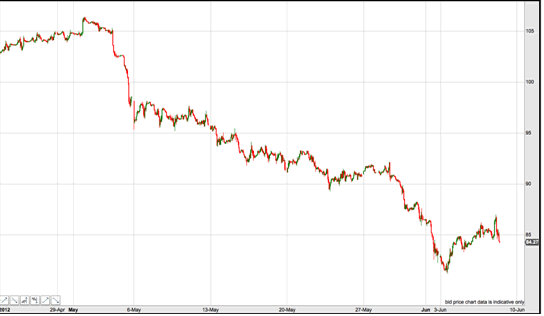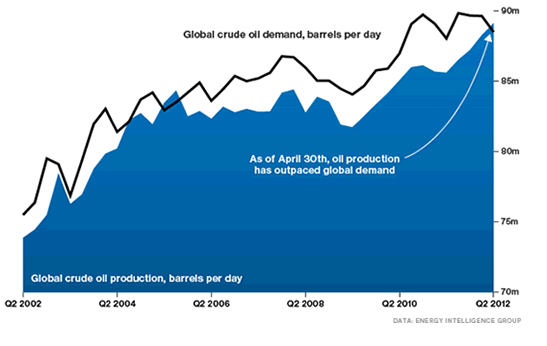 Last month I blamed the upcoming presidential elections for the downward pressures on oil prices.
Last month I blamed the upcoming presidential elections for the downward pressures on oil prices.
At the time, the market was full of conspiracy theories that someone in the White House was helping to manipulate oil prices to the downside, and the feeling was that oil wouldn’t see any movement to the upside until after the November elections.
And since then… oil has suffered its worst run of losing days since January 1997…

While it’s true that the administration will usually try to squeeze down oil prices in an election year – in an attempt to woo voters – I reckon there’s got to be more afoot here.
Even President Obama, arguably the most powerful man on the planet, probably couldn’t put that kind of squeeze on oil prices.
How to trade oil
Before we look at what’s squeezing oil, and how we can profit from it, let’s first get a bit of background on trading oil …
Oil is generally considered to be the most important commodity. It may not feed one third of the planet’s population, like rice does, but oil is needed for fertilizers, for distribution, and without oil, most of the world’s economies come to a grinding halt.
Even if you’ve no interest in trading commodities, oil is affecting every index, currency and stock that you look at. It affects the big-picture fundamentals, like output … inflation … consumer spending … and it affects the specifics, like how much money’s left in your wallet after you’ve filled the tank.
So, first off, let’s be clear what we’re trading here – we’re talking about the thick black goo that comes out of the ground. The stuff that is then refined to bring us petrol for our cars … heating oil for our homes … and everyday plastics.
When you go to your trading platform to check the price of oil, you’ll probably find two different types of oil: Brent crude and US crude.
Brent Crude is the oil that comes from the North Sea, and two thirds of the world’s internationally traded oil is priced relative to UK Brent Crude – whether it’s been drilled in the North Sea or elsewhere in Europe, Asia, Africa or the Middle East.
US Crude is also known as US light sweet or West Texas Intermediate. This is oil that comes out of the ground on America, which contains less sulphur and so has a sweeter smell.
What drives oil prices?
There are an enormous number of factors that affect oil prices, but top of the list are …
- Political unrest in oil-producing regions
- Economic growth (or otherwise) – if the economies are booming, then demand for petrol and consumables increases.
- Opec: the Organization of the Petroleum Exporting Countries collectively hold around 80% of the world’s crude oil reserves, which means they have the power to manipulate oil prices.
- The driving season runs from May to September, which is the time of year when Americans tend to spend their weekends away, leading to a sharp increase in the demand for fuel at the pumps.
- US election years tend to see a fall in the price of oil as the current administration endeavour to curry favour with voters.
- Concerns over peak oil (the theory that we have already seriously depleted the planet’s oil resources) means that many traders feel bullish about oil in the very long-term. However, the flip-side to this is that new techniques of oil extraction are being developed, and new energy sources exploited.
What’s gone wrong for oil?
This week oil fell as low as $81 a barrel, it’s weakest level since October 2011, on the back of yet more depressing news about the global economic recovery.
Last Friday we saw weak employment figures from the US, and then over the weekend we got China’s non-manufacturing PMI.
The commodity markets seem to be losing confidence in the ability of world leaders to deal with the economic slowdown … debt in Europe … and a weak banking sector.
Plus, for the first time since 2006, we see the supply of oil outstripping demand …

[Image Source: Bloomberg]
So, as we see global economies struggling, will the price of oil keep on falling?
So far this week, we’ve seen some strength come back into oil prices, with yesterday’s surprise interest rate cut from China causing an upward spike. However, these gains were quickly wiped out over the afternoon, following a handful of warnings and downgrades from ratings agency Fitch.
All these things suggest that the direction for oil in the short term should be downwards.
But the key resilience of oil prices is that the oil-producing nations control supply, and can cut production to boost prices. Saudi Arabia need prices to stay around the $100 level. The Arab Spring led to many Gulf states buying social peace with handouts from the government. Saudi Arabia needs $77 a barrel just to break even this year, and will need $98 in 2016. Oil prices much below $100 would threaten the stability of many Gulf states. And – fortunately for them – they have the power to ensure that prices stay high in the medium term.
So, if oil is cheap now – should we be buying it?
My advice is no. Perhaps I’m a cynic, but I simply can’t bring myself to feel bullish about oil until the presidential election is over.
